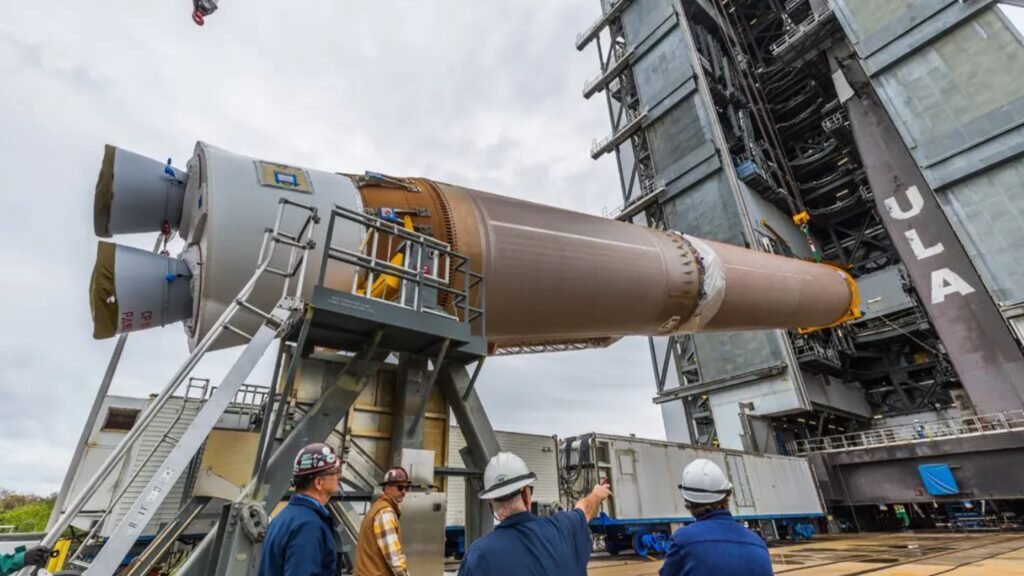Amazon Project Kuiper is a large-scale satellite internet initiative launched by Amazon, aiming to provide fast, reliable, and affordable broadband internet to underserved and remote regions globally. Approved by the U.S. Federal Communications Commission (FCC), the project represents Amazon’s foray into the rapidly growing satellite broadband market, currently dominated by competitors like SpaceX’s Starlink.

Unlike traditional internet infrastructure, which depends on ground-based fiber networks that are expensive and time-consuming to expand in rural or difficult terrains, Amazon Project Kuiper plans to blanket the Earth with thousands of satellites that communicate with user terminals on the ground. These satellites will work in unison with Amazon Web Services (AWS), combining cloud computing and satellite technology to create a seamless, low-latency network.
KA-01 Mission Overview: A Launch That Signals a New Era
The KA-01 mission was set to launch on April 9, 2025, using the powerful Atlas V rocket provided by United Launch Alliance (ULA). The mission would have placed 27 fully operational satellites into Low Earth Orbit at an altitude of approximately 280 miles (450 km). These satellites are the most advanced ever developed under Amazon Project Kuiper, featuring state-of-the-art phased array antennas, onboard processing, and optical inter-satellite links that allow satellites to talk to each other without ground relay.
The purpose of KA-01 goes far beyond just proving the technology—it is the first significant step in populating Amazon’s global broadband network. The success of this mission is vital, as it forms the core of the eventual deployment of over 3,200 satellites in space by 2029.
Unfortunately, due to weather-related concerns, including strong upper-level winds and cloud interference, the launch was postponed. New launch dates are expected to be announced soon.
Why the Delay Matters
While the delay may seem minor, it draws attention to the complexity of satellite launches. A single miscalculation or unfavorable weather condition can delay millions of dollars’ worth of planning. However, Amazon remains committed to the timeline of Amazon Project Kuiper, aiming to meet the FCC’s requirement of launching at least 1,618 satellites by July 2026. Missing this milestone could jeopardize future operations and competitive standing.
Despite this delay, the enthusiasm surrounding Amazon Project Kuiper has only intensified. Engineers are already working on follow-up missions, including KA-02, which will likely launch using the same ULA Atlas V configuration.
What Makes This Satellite Constellation Unique?
The 27 satellites aboard the KA-01 mission are designed for speed, stability, and adaptability. Here’s a look at what makes the technology behind Amazon Project Kuiper so innovative:
- Advanced Antennas: Custom-designed phased array antennas can electronically steer beams of data across the planet, adapting in real time to maintain strong connections.
- Inter-Satellite Optical Links (ISLs): These laser communication systems enable satellites to communicate directly, reducing reliance on ground stations.
- Solar-Powered Efficiency: Each satellite is equipped with extended solar arrays and advanced thermal management to ensure longevity.
- Collision Avoidance: AI-powered propulsion systems ensure that satellites avoid space debris and maintain their correct orbits.
All this is housed in compact, lightweight satellites that are easier to mass-produce and deploy, a hallmark of Amazon Project Kuiper engineering.
Real-World Impact: Who Will Benefit?
Amazon Project Kuiper isn’t just about innovation—it’s about transformation. The project is designed to reach:
- Remote communities with little to no internet access
- Students in rural schools
- Medical centers that need real-time data transmission
- Small and medium businesses operating in remote areas
- Government and emergency response teams needing instant connectivity in disaster zones
This democratization of connectivity is central to Amazon’s broader mission of “Everywhere Internet,” where location no longer determines access to opportunity.
Amazon’s Investment and Workforce
Amazon has invested billions of dollars into Amazon Project Kuiper, including the development of new satellite processing facilities, ground stations, and manufacturing lines. Over 2,000 engineers, developers, and scientists are currently dedicated to the project, with many recruited from aerospace, telecommunications, and cloud technology backgrounds.
A sprawling new satellite production facility in Kirkland, Washington, will serve as the manufacturing hub for future satellites. With this infrastructure in place, Amazon can build and launch satellites at scale.
The Starlink Rivalry
Inevitably, comparisons are drawn between Amazon Project Kuiper and SpaceX’s Starlink. While Starlink already has a head start with over 8,000 satellites in orbit, Amazon is playing the long game. By integrating with AWS and offering flexible pricing models, Amazon Project Kuiper hopes to capture large institutional contracts—governments, educational bodies, and emergency services—beyond just consumer markets.
Moreover, Amazon’s commitment to affordability could make the service accessible to more users. Jeff Bezos has made it clear that Amazon Project Kuiper is a long-term bet on technological equity.
Launch Plans and Partnerships
In one of the largest commercial launch deals ever, Amazon has reserved more than 80 rocket launches from ULA, Arianespace, Blue Origin, and SpaceX. These contracts will facilitate satellite deployment at a rapid pace over the next five years.
The KA-01 launch is just the beginning. Upcoming missions will use a mix of rockets including:
- Vulcan Centaur (ULA)
- Ariane 6 (Arianespace)
- New Glenn (Blue Origin)
- Falcon 9 (SpaceX)
This diversified launch strategy ensures resilience and flexibility in case of delays or technical issues with any single provider.
What Happens After the KA-01 Launch?
Once launched, the satellites will go through a detailed post-deployment phase:
- Separation from the launch vehicle in space
- Activation of onboard systems
- Orbit-Raising Maneuver using propulsion Kuiper systems to reach 630 km altitude
- Integration with Kuiper’s ground network and AWS cloud services
This stage is essential for confirming satellite performance and preparing for commercial services.
R&D and Future Enhancements
Amazon Project Kuiper also serves as a platform for future research. Amazon plans to test edge computing, AI in space, and interconnectivity with terrestrial 5G networks. These advancements will ensure Kuiper remains relevant and competitive for decades to come.
Additionally, environmental responsibility is a key part of the mission. Satellites are designed to safely deorbit after their operational life, reducing the risk of space debris.
Official Statement
“This launch represents years of effort and innovation. We’re building a new system from the ground up—one that can benefit millions worldwide. The delay won’t stop us. Amazon Project Kuiper is about the long view.”
— Rajeev Badyal, Vice President of Technology, Amazon Project Kuiper
Final Thoughts
While the KA-01 mission has been delayed, the momentum behind Amazon Project Kuiper is undeniable. This pioneering effort by Amazon to revolutionize internet connectivity is not just a tech venture—it’s a humanitarian mission, a commercial strategy, and a giant leap for satellite innovation.
With powerful partnerships, advanced technology, and a clear vision, Amazon Project Kuiper is poised to reshape how the world connects—one satellite at a time.
Stay Connected with the Future of Global Internet!
Stay Ahead with the Latest Tech and Space Innovations!
Don’t miss out on groundbreaking updates like Amazon Project Kuiper and other global stories shaping our future.
Subscribe now to Hours of News for real-time, trusted news — updated every hour!
Share this article and be the first to spark the conversation.


